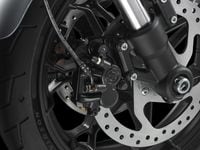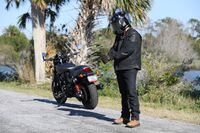Harley-Davidson raised plenty of eyebrows including ours when they unveiled its Street platform at the 2013 EICMA show in Milan, Italy. Since then, global sales of the mid-displacement cruiser with a plain-Jane name and minimalist styling have pleased the front office in Milwaukee, enough so that H-D's project planning department got the go-ahead to build a new Street-based performance model for 2017. Enter the new-for-2017 Street Rod, a motorcycle that is about as un-cruiser-like as you can get while still bearing the Harley-Davidson name (but no Bar & Shield) on the tank.
The Street Rod project launched not long after the 2013 Street unveil and was officially in the hands of H-D's Styling and Design studio by the start of 2014. The target market was no longer an entry-level rider seeking a mid-sized cruiser. Instead, the style and performance of the new Street Rod is geared for the young urban rider who not only knows how to ride, but enjoys the thrill of a sportier bike. Lead stylist Chetan Shedjale calls it the "urban bulldog" and pointed out during the Daytona Bike Week press introduction that many design cues were taken from the racy Street-based RDX 800 (pictured below), one of three concept bikes built by the Harley-Davidson design studio and the one that was most liked by spectators at the 2013 EICMA unveil.
But enough back story. How do we like the Street Rod and how does it perform?
The first thing confirming that this was no Harley cruiser was my leg position, or more precisely, how high I had to hoist my left leg up to get my foot on the peg to kick it into gear. Comfort is a relative term here and while taller riders, say 5-11 and above or riders with extra girth around the midsection (Okay, fat guys!), will likely not fit comfortably on the Street Rod, I found the ergos to be perfect for my 5-9/185 dimensions. I asked the Street Rod’s Lead Engineer Brian Dondlinger how he fit on the bike that he helped to design (he’s a big guy at over 6 feet tall) and his reply was that he didn’t because the height demographic for the Street Rod targets riders in the 5-5 to 5-9 height range.
But it wasn't a total win for me either. Overall I fit the bike perfectly, but I had an issue with the positioning of my right boot while riding. I couldn't get my foot into a comfortable position and still be able to cover the rear brake lever. During the press ride I asked Dondlinger why the peg was so close to the pipe that they had to install a heel pad on top of the heat shield. He explained that although the exhaust can is new, the header pipe is carried over from the Street 750 and keeping it was one of the design compromises that his department had to make to stay within budget. With the foot control located higher up and more to the rear, the heel pad was the best and quickest solution. To get my size 9 boot to fit somewhat comfortably on the right peg, I adjusted the brake lever all the way down to its lowest point. If I owned the bike, my fix would be to toss the whole pipe in favor of a scrambler-style exhaust if and when it becomes available. Vance and Hines, are you listening?
Once up and moving, I noticed the clutch was grippy and difficult for me to launch smoothly. Dondlinger confirmed this and helped me out again with a clutch lever adjustment. After adding a little more play than normal, I found it much easier to manage and had no further complaints.
I love the look and feel of drag bars and they play a major role in the Street Rod’s aggressive look and rider position. Personally I would cut them down an inch on either side but on the positive side, the width of the bars provided excellent rearview visibility from the left and right bar-end mirrors.
The performance difference between the Street Rod and the standard Street 750 is huge. The claimed increases in horsepower (18 percent) and torque (8 percent) are immediately evident. I’m not much of a wheelie guy but I think Henning and Courts would have the front wheel off the ground most of the time. The long straight roads around Daytona allowed several opportunities to redline the High Output Revolution X engine and it did so smoothly with no dead spots in the power band. At 60mph, I kicked it down two gears and twisted the throttle. I felt the engine pull strongly, hitting the rev limiter at 9,000 rpm. It felt like there was more to go.
The roads of Florida might be good for straight-line throttle fun but they didn’t provide much opportunity to put the re-engineered chassis and suspension to the test. Fortunately, I was one of the few journalists on the launch who opted to stay with the ride for the final photo session, which took us through a section of twisty (but flat) roads. Not the ideal romp for a full suspension evaluation but enough to feel how quick the steering is over the standard Street 750, thanks to the Street Rod’s reduced rake angle at 27 degrees (the standard Street 750 rake is 32 degrees). The new inverted fork front end takes you into the turns predictably and is matched with new external-reservoir rear shocks that increase swingarm travel by a claimed 31 percent. Canyon aptitude runs high with this Harley.
Those "crummy brakes" that we noted in our 2015 Small Cruiser Comparison are not part of the Street Rod package. While the rear setup is essentially unchanged, the fronts have been upgraded from a single to dual 300mm discs with ABS now optional (our test bike was so equipped). The new binders may not be sportbike stellar but they're good enough to remove them from our gripe list.
Fit and finish. It was one of the biggest fails of the standard Street and we pulled no punches in calling out the Motor Company on this issue. Apparently they listened and were quick to point out that these details were high on the list of priorities to fix for the new Street Rod. Dondlinger says that he and his engineering team were on the assembly line for the first three weeks of production to watch over the build quality and to solve any fitment issues that came up. After giving everything from paint and bodywork to frame welds and wiring a thorough inspection, we found nothing irregular.
As our test day was winding down and Daytona Bike Week traffic was building up along our return route via Atlantic Avenue, I had the unique experience of sitting on the Street Rod for a long stretch of road in stop-and-go traffic without the option of lane-splitting (SoCal rider here). The ambient temperature was cool in the low 50s but my inner thighs were on fire (bear in mind that this was Bike Week traffic!). And to compound the situation, there was that exhaust pipe again; only this time the problem was how far it sticks out. With a 30-inch inseam, I had to make an effort to position my right leg wide and away from the pipe to avoid scorching my jeans while at a stop. Riders with shorter legs might have a problem here.
So does Harley-Davidson have a winner here? In most respects, the answer is absolute. I consider myself part of the company’s aging group of core owners (I own a ’97 Softail Springer and I started riding Harley choppers back in the ‘70s) who was less than enamored with the Street 750. But the 2017 Street Rod is whole different animal. It’s got style, performance, aggressive ergos, and it has the bar-and-shield brand heritage that makes motorcycling for guys like us a lifetime experience. And all that comes with a base price well under $10K. So who cares if my leg gets hot in heavy Bike Week traffic or my foot feels a little awkward on the right peg. This bike looks cool, is fun to ride, and is affordable. That adds up to a winner in my book.











/cloudfront-us-east-1.images.arcpublishing.com/octane/Q6HCDLVWWPYQHC5B3SDW463N7Y.jpg)









/cloudfront-us-east-1.images.arcpublishing.com/octane/5FWDJG3A6G2BRCFDH2YVFVFQM4.jpg)

/cloudfront-us-east-1.images.arcpublishing.com/octane/G4MG6OUCJNBSHIS2MVVOTPX65E.jpg)
/cloudfront-us-east-1.images.arcpublishing.com/octane/IIGGWFOTOJGB7DB6DGBXCCMTDY.jpg)
/cloudfront-us-east-1.images.arcpublishing.com/octane/QSTCM6AVEZA5JJBUXNIQ3DSOF4.jpg)
/cloudfront-us-east-1.images.arcpublishing.com/octane/U4I7G625B5DMLF2DVIJDFZVV6M.jpg)
/cloudfront-us-east-1.images.arcpublishing.com/octane/B6XD6LS6IVCQPIU6HXDJSM3FHY.jpg)
/cloudfront-us-east-1.images.arcpublishing.com/octane/ICL63FEDDRDTTMINYICCEYGMDA.jpg)
/cloudfront-us-east-1.images.arcpublishing.com/octane/FCGZHQXRBZFLBAPC5SDIQLVF4I.jpg)
/cloudfront-us-east-1.images.arcpublishing.com/octane/WNOB6LDOIFFHJKPSVIWDYUGOPM.jpg)

/cloudfront-us-east-1.images.arcpublishing.com/octane/X33NU3E525ECRHXLNUJN2FTRKI.jpg)
/cloudfront-us-east-1.images.arcpublishing.com/octane/6KKT5NNL2JAVBOXMZYS5ZO76YA.jpg)
/cloudfront-us-east-1.images.arcpublishing.com/octane/J5RKG5O455GMPGQRF2OG6LRT7A.jpg)
/cloudfront-us-east-1.images.arcpublishing.com/octane/GX2CIZKQVRH2TATDM26KFG2DAE.jpg)
/cloudfront-us-east-1.images.arcpublishing.com/octane/ZWIDYSAKQZHD5BHREMQILXJCGM.jpg)
/cloudfront-us-east-1.images.arcpublishing.com/octane/CYUHJZCTSJCH3MRAQEIKXK7SCQ.jpg)
/cloudfront-us-east-1.images.arcpublishing.com/octane/LKOFINY56FCXJCANJ5M7ZDQUBY.jpg)
/cloudfront-us-east-1.images.arcpublishing.com/octane/4NBPDACMWJH63JQYJVK3QRBDZI.jpg)
/cloudfront-us-east-1.images.arcpublishing.com/octane/KKHQHRR3FJGX7H2IPU6RALMWG4.jpg)

/cloudfront-us-east-1.images.arcpublishing.com/octane/5IOFS5JAE5FOXMNA23ZRAVVYUU.jpg)
/cloudfront-us-east-1.images.arcpublishing.com/octane/CGXQ3O2VVJF7PGTYR3QICTLDLM.jpg)

/cloudfront-us-east-1.images.arcpublishing.com/octane/OQVCJOABCFC5NBEF2KIGRCV3XA.jpg)
/cloudfront-us-east-1.images.arcpublishing.com/octane/OPVQ7R4EFNCLRDPSQT4FBZCS2A.jpg)